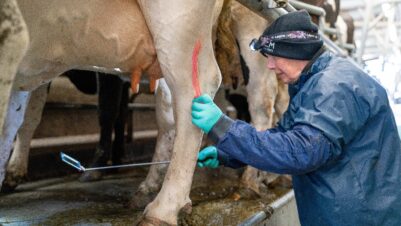RECENT years have shown a gradual increase in the frequency and type of diseases transmitted by biting insects. Grouped loosely under the name of Arboviruses (arthropod-borne viruses), they affect a wide variety of animals, including humans.
Names such as bluetongue, African Horse Sickness and West Nile Virus, hitherto relatively unknown in the western hemisphere, are now clearly recognised as potential dangers to public health.
West Nile virus is a classic example of an “emerging” or “exotic” disease. Classified as a member of the Flaviviridae family, West Nile virus uses wild birds as reservoirs to harbour and transport it into new areas. Insects serve to transmit the disease by taking a blood meal from an infected bird and inadvertently passing it on to subsequent victims.
The origins of this virus are very old – indeed, one team of scientists has even postulated that it was West Nile virus that caused the death of Alexander the Great1 . Two weeks before his death, the emperor describes an unusual and foreboding event in which large flocks of ravens wheeling overhead suddenly die midflight and come crashing to the ground in front of him. Sudden deaths in wild birds are often a sentinel sign of West Nile virus.
Whether West Nile virus did indeed claim one of the world’s most famous and powerful leaders cannot be proven with any degree of certainty. Given the sudden onset and rapid, feverish deterioration of this battle-hardened warrior, it does, however, make an intriguing and plausible argument.
What is certain is that West Nile virus was of little concern to the modern western world until 1999 when it was discovered to have caused an outbreak of human encephalitis in New York City. From there it spread rapidly across the continental United States, Canada and Latin America.
At the peak of the outbreak in 2002, there were 15,257 recorded cases of West Nile virus in horses alone. Fortunately, in that same year, a vaccine was developed for use in horses.
With proactive implementation of the vaccine, the number of cases recorded in horses throughout the United States had plummeted to 1,406. Conversely, the number of encephalitis cases in humans continued to rise steadily during the same time period.
Culex mosquito
The main transmitter of the virus is the Culex mosquito. The incidence of WNV is, therefore, closely bound to the cycle of this insect, with typical peak activity beginning in July and extending through October.
The Culex and other avian feeding species serve to amplify the virus and transmit it throughout the bird population. Infected birds carry sufficient virus within the blood to reinfect other blood-sucking mosquitoes.
Susceptible birds, in particular sparrows, crows, jays and magpies suffer high (>40%) mortality rates.
Hybrid mosquitoes that take blood meals from birds and mammals alike are important vectors in transmitting the disease to other species. While some species such as cats, dogs, and cattle generally develop immunity without becoming ill, man and equid appear particularly susceptible to WNV symptoms. However, because the virus cannot amplify itself within the blood of non-avian animals, these vectors are often referred to as “dead end hosts”.
West Nile infection in both humans and horses typically begins with unspecific symptoms such as fever, lethargy and other flu-like symptoms. In immune compromised or elderly patients, the virus can spread to the central nervous system where it may cause severe encephalitis.
Initial signs in horses are typically muscle fasciculations in the head area; generalised tremors involving the entire body may also occur. These symptoms can rapidly progress to ataxia, hind-limb paralysis or even complete recumbency in a short period of time. The mortality rate for neurologically affected horses is typically high (23- 43%).
Treatment of the condition is not curative, but relies on symptomatic relief only. This treatment is intensive, time-consuming and expensive. It involves the administration of copious amounts of intravenous fluids as well as regular injections of pain killing agents and sedatives.
Most importantly, the horses need to be protected from harming themselves. For this, protective headgear, lifting apparatus with support slings, and padded boxes are necessary to improve the survival rate. Nutritional support may also be necessary if horses are unable or unwilling to eat. These environments are generally only to be found in well-equipped hospitals.
West Nile Virus caused a major outbreak in Italy in 2009, affecting over 200 horses. It is now considered to be endemic there. Research has shown that this virus is a lineage 1 strain and is very closely related (98.8%) to a strain that was identified in Tuscany in 1998.
In other words, the viral strain has reappeared after 10 years of dormancy! In addition, separate outbreaks of unrelated lineage 2 strains, particularly in Hungary, have also arisen in last two years. Migratory birds from Africa are the most likely culprit for these outbreaks.
In response to these recent outbreaks, a European licence was granted to Fort Dodge Animal Health for its West Nile vaccine. This is the same vaccine that was employed to prevent clinical disease in horses during the outbreak in the United States.
Although the initial focus will be to protect horses travelling to countries in which WNV is present, the vaccine is available throughout the UK for owners concerned with the increased threat. The UK Driving Team horses became the first animals to be vaccinated in the UK as they plan to compete in Hungary in August.
1. Marr, J. S. and Calisher, C. H. (2003) Alexander the Great and West Nile virus encephalitis. Emerg Infect Dis 19: 12.
Available from: www.cdc.gov/ncidod/EID/vol9no12/03- 0288.htm.






